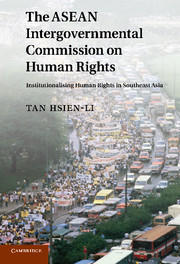 The ASEAN Intergovernmental Commission on Human Rights
The ASEAN Intergovernmental Commission on Human Rights Book contents
- Frontmatter
- Contents
- List of tables
- Preface
- 1 Charting the human rights institutionalisation process in Southeast Asia
- 2 Enough of ‘Asian values’: roots of the ASEAN states' reticence towards human rights
- 3 Self-determination and democracy: the human rights experiences of five ASEAN states
- 4 Instituting the regional rights regime: the ASEAN Intergovernmental Commission on Human Rights (AICHR) and the role of civil society
- 5 Human rights understanding between the ASEAN region and the United Nations: convergence, regional cohesion, and national responsibility
- 6 The unexplored aspect of human rights: what ASEAN needs to understand about the right to development
- 7 Sustaining AICHR's substantive empowerment: implementation, integration, and international law
- Bibliography and sources
- Index
7 - Sustaining AICHR's substantive empowerment: implementation, integration, and international law
Published online by Cambridge University Press: 07 September 2011
- Frontmatter
- Contents
- List of tables
- Preface
- 1 Charting the human rights institutionalisation process in Southeast Asia
- 2 Enough of ‘Asian values’: roots of the ASEAN states' reticence towards human rights
- 3 Self-determination and democracy: the human rights experiences of five ASEAN states
- 4 Instituting the regional rights regime: the ASEAN Intergovernmental Commission on Human Rights (AICHR) and the role of civil society
- 5 Human rights understanding between the ASEAN region and the United Nations: convergence, regional cohesion, and national responsibility
- 6 The unexplored aspect of human rights: what ASEAN needs to understand about the right to development
- 7 Sustaining AICHR's substantive empowerment: implementation, integration, and international law
- Bibliography and sources
- Index
Summary
In the six preceding chapters, we traced the development of the international human rights discourse, uncovered the roots of the Association of Southeast Asian Nations (ASEAN) member states' suspicions of the global human rights enterprise as an impingement upon their closely guarded sovereignty, and finally witnessed how the gradual interaction between human rights and ASEAN brought about the eventual establishment of the ASEAN Intergovernmental Commission on Human Rights (AICHR). Acknowledging that although AICHR in its initial phase of its mandate has not been able to promote and protect human rights of an international standard as it is supposed to, one believes that AICHR's establishment was not a mere window-dressing exercise for ASEAN. ASEAN wants to transform into a credible regional organisation that abides by the rule of law and upholds the norms of the international legal order, and that includes human rights. Moreover, while human rights progress can be obstructed and delayed, it cannot be averted or deflected. Once set in motion, societal and political change will occur in ASEAN societies so as to procure, in due course, a bettering of human rights standards. This would come about through governmental and grassroots transformation through the passage of time.
Therefore, to keep ASEAN's institutionalisation of human rights throughout the region on track, there are three core principles that AICHR, in the execution of its duties, must bear in mind.
- Type
- Chapter
- Information
- The ASEAN Intergovernmental Commission on Human RightsInstitutionalising Human Rights in Southeast Asia, pp. 248 - 256Publisher: Cambridge University PressPrint publication year: 2011


